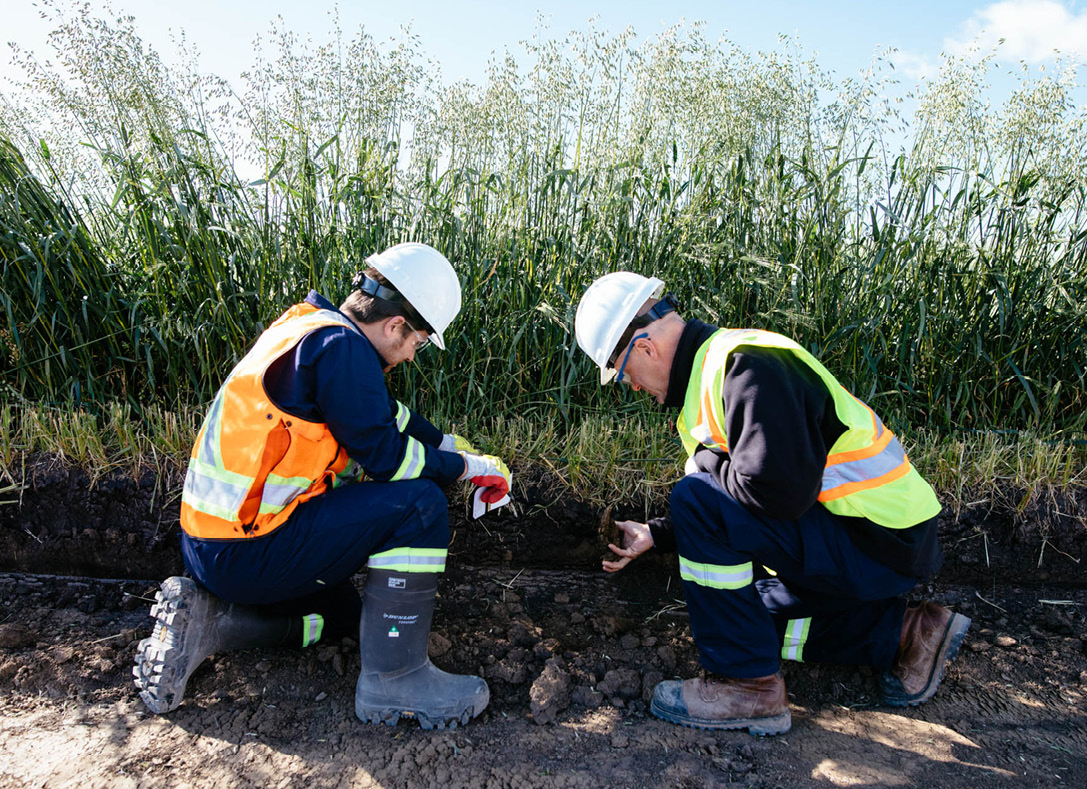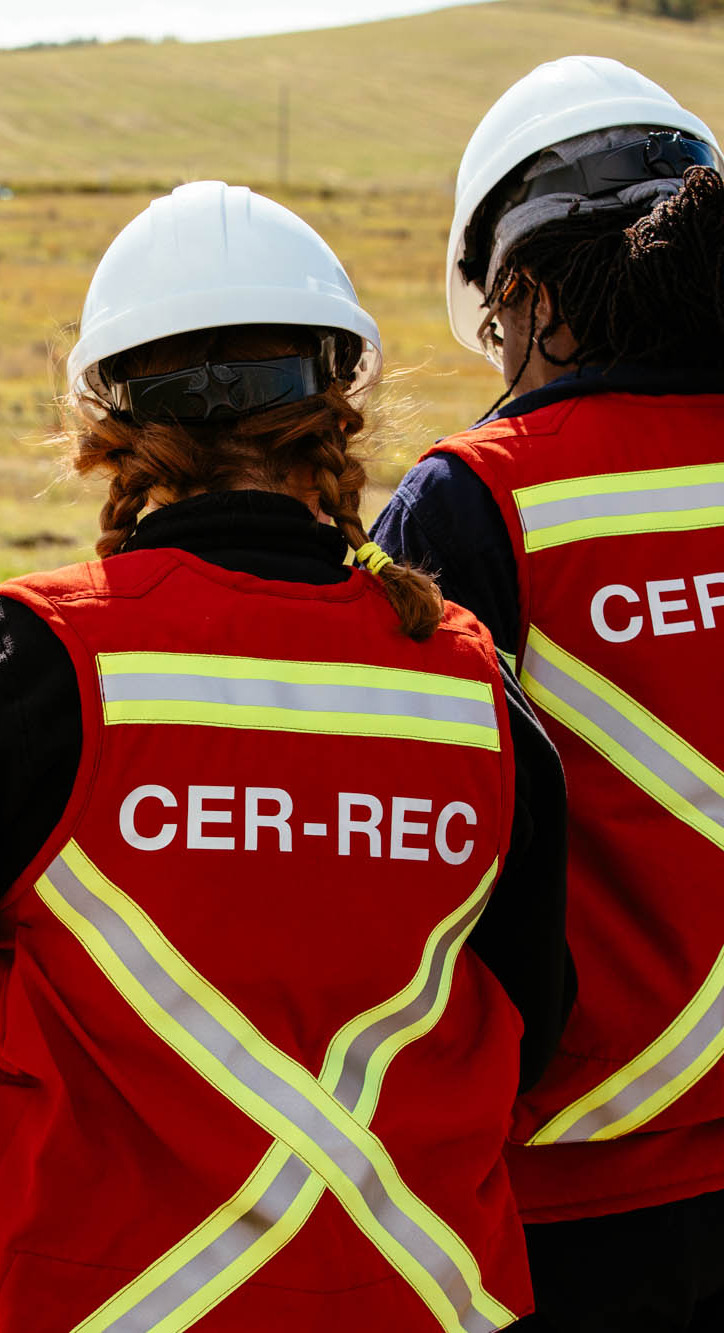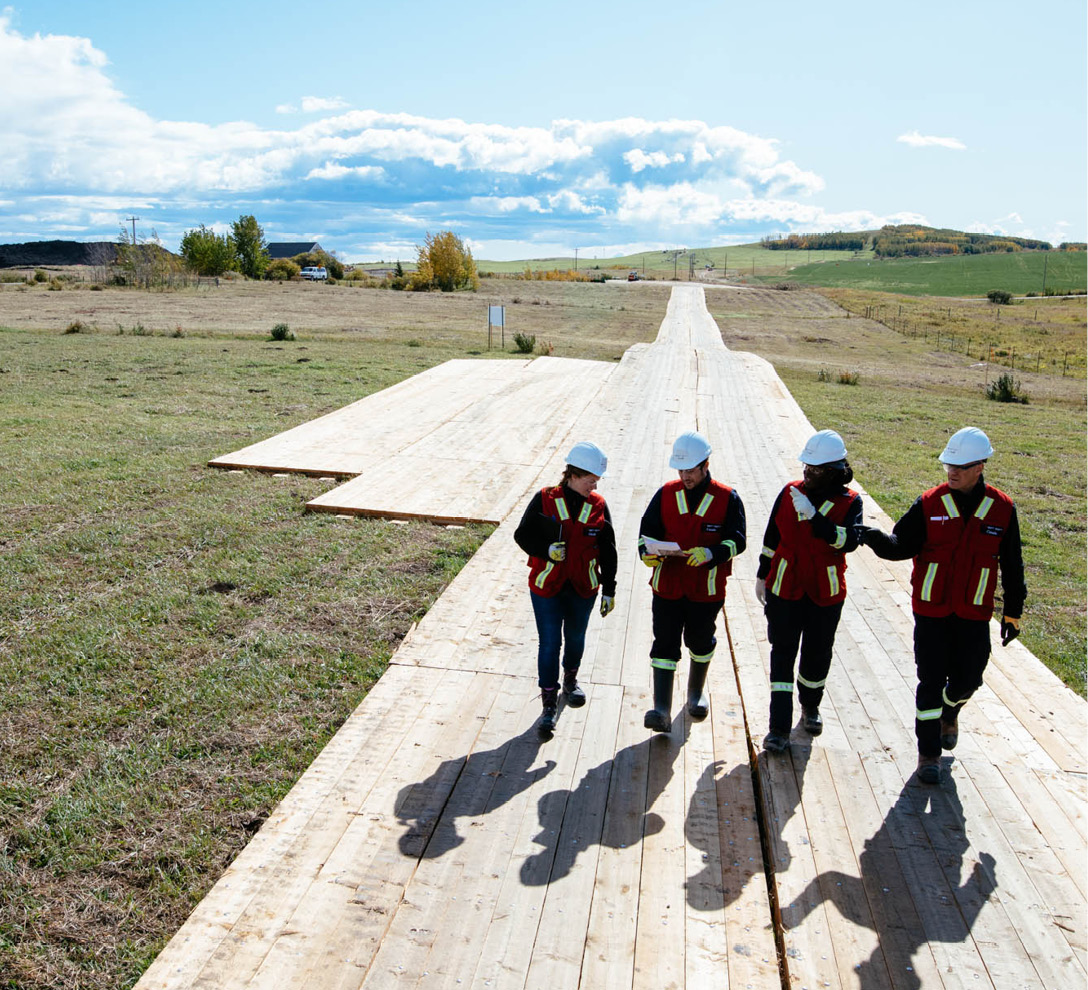2022–23 Annual Report of the Canada Energy Regulator – Core Responsibilities: The CER’s Achievements in 2022–23

Core Responsibility: Safety and Environment Oversight
The CER works for Canadians to keep energy moving safely and efficiently through the country’s pipelines and powerlines. The organization performs this function by setting and enforcing regulatory expectations for companies over the entire lifecycle of federally regulated energy infrastructure – construction, operation, and abandonment.
 The CER enforces some of the strictest safety and environmental standards in the world, and its oversight goes beyond simple compliance. The organization promotes best practices to reduce the potential for harm, adopting new technologies and innovative approaches to improve the effectiveness and efficiency of a company’s management system to prevent harm.
The CER enforces some of the strictest safety and environmental standards in the world, and its oversight goes beyond simple compliance. The organization promotes best practices to reduce the potential for harm, adopting new technologies and innovative approaches to improve the effectiveness and efficiency of a company’s management system to prevent harm.
Regulated companies must have emergency management programs, including a robust continuing education program for the police, fire departments, medical facilities, other agencies, and people who live or work near the pipeline. The CER also expects companies to engage with all people living and working near pipelines, including Indigenous Peoples, the public, contractors, landowners, and municipalities, to promote safe work practices and actions they can take to prevent damage to pipelines.
The CER’s Commitment
- Harm to people and the environment, through the lifecycle of energy-related infrastructure, is prevented.
Preventing harm is the foundation of how the CER keeps people safe and protects the environment.
Performance Results Summary 2022–23 – Safety and Environment Oversight
Performance Measure |
Target |
Results |
Results |
Results |
|---|---|---|---|---|
Number of serious injuries and fatalities related to regulated infrastructure. |
0 |
12 |
||
Number of incidents related to regulated infrastructure that harm the environment. |
0 |
7 |
||
Percentage of unauthorized activities on regulated infrastructure that involve repeat violators. |
<15% |
11% |
10% |
16%Footnote 4 |
Compliance Verification Activities
The CER aims to achieve zero incidents, meaning there is no harm to people or the environment on the energy infrastructure it regulates. The CER follows a risk-based approach in planning and conducting Compliance Verification Activities (CVAs). When the activities of regulated companies have the potential to pose greater harm to people or the environment, the CER increases oversight through engagement, inspections, investigations, audits, and enforcement, when necessary.
In 2022–23, the CER conducted 257 CVAs, which included:
135
Inspections
20
Emergency Response
Exercises
6
Management System
Audit Reports
15
Compliance
Screening
Meetings

24
Implementation
Assessment
Meetings
50
Information Exchange
Meetings
7
Manual Reviews

In 2022–23:
- 283 conditions were closed during 2022–23 and 323 new project specific conditions were issued.
- 1394 post-approval documents were filed with the CER.
- 541 Operations and Maintenance notifications were reviewed as part of ongoing oversight of operating facilities.
- 2467 active conditions.
In addition to CVAs, the CER provides oversight in other ways, such as:
- analyses of the root causes of incidents to ensure appropriate corrective actions or to identify preventive actions;
- examination of authorizations conditions to verify that companies are taking the necessary steps to comply with these conditions;
- responses to emergencies when they happen to verify that companies are protecting the safety of people and minimizing and remediating any environmental damage;
- reviews of Operations and Maintenance notifications as part of ongoing oversight of operating facilities;
- reviews of Notices of Contamination to oversee companies' management of contamination and remediation activities.
Construction Oversight of the Trans Mountain Expansion Project and NGTL Projects
TMX Project
In 2022–23, construction activities on the Trans Mountain Expansion Project (TMX) continued across all pipeline work areas, including at terminals, pump stations, and on portions of the project to be reactivated near Jasper, Alberta. The CER continues to hold the company accountable for fulfilling project conditions and for meeting its regulatory obligations and commitments, including as it transitions to the operational phase.
The CER completed 66 CVAs on TMX in 2022–23, including inspections, emergency response exercises, and compliance meetings. Indigenous Monitors from the IAMC-TMX participated in 57 Inspections with CER staff. Review of project condition compliance filings continued throughout the year, and consideration of applications such as route deviations and requests for leave to open to bring specific project components into service.
In 2022–23, the company was required to report serious injuries that occurred during construction, near-miss events, and incidents that harmed the environment. Injuries associated with TMX were predominantly due to slips and trips, and incidents that harmed the environment were typically associated with watercourse crossings. In all cases, the CER followed up with the company to ensure that it took appropriate follow-up or corrective actions.
CER Inspection Officers issued one Order during 2022–23 after having observed inconsistent practices for respiratory protective equipment by workers performing or participating in welding tasks.
See Appendix F for more information on Inspection Officer Orders issued in 2022–23.
NGTL Projects
Construction activity occurred on three major NGTL projects throughout 2022–23: NGTL’s 2021 System Expansion Project (NGTL 2021), the Edson Mainline Expansion Project, and the North Corridor Expansion Project.
The company’s construction on the NGTL 2021 and Edson Mainline projects concluded during the year. The CER completed 10 CVAs on those NGTL projects, including inspections, emergency response exercises, and compliance meetings, with Indigenous Monitors participating in nine of them.
During construction of the North Corridor Expansion project, a serious injury to a worker occurred while offloading pipe from a truck in August 2022. CER Inspection Officers attended the site and issued an Order to NGTL requiring it to cease that specific activity until corrective measures were in place.
Indigenous Monitoring
The CER is committed to advancing Reconciliation with Indigenous Peoples and finding new ways to include Indigenous Peoples in the oversight of federally regulated infrastructure, as it builds trust and confidence while strengthening environment and safety oversight. The CER continues to increase the involvement of Indigenous Monitors through several aspects of its compliance verification activities.
Indigenous Advisory and Monitoring Committees
IAMCs enable Indigenous Nations to oversee project construction and operation by “getting boots on the ground." Examples during 2022–23 include the IAMC-TMX, which continued to conduct joint compliance verification activities with CER inspection staff, focusing primarily on protecting Sites of Indigenous Significance and watercourse crossings. The CER and IAMC-TMX worked together to respond to the input provided by Indigenous communities and ensure that their priorities are reflected in the monitors’ work.
IAMC-TMX Indigenous Monitors conducted 42 compliance verification activities jointly with CER Inspection Officers in 2022–23. These CVAs included 31 Field Inspections, three Implementation Assessment Meetings, five Information Exchange Meetings, and three Emergency Response Exercises.
For the Enbridge Line 3 project, the CER and Indigenous Monitors from the IAMC-Line 3 completed six Field Inspections.
CER’s NGTL Indigenous Monitoring Program
The CER has its own Indigenous Monitoring Program for the NGTL system. The program continued through a critical phase in 2022–23, establishing contracts to enable the participation of Indigenous Monitors in safety and environmental compliance and oversight activities for the NGTL System. Indigenous Monitors completed nine Field Inspections of various construction spreads of NGTL project construction.
CER Indigenous Monitoring Bridging Program
The CER continued its Indigenous Monitor Bridging Program in 2022–23, which provides opportunities for Indigenous Monitors to join the CER as Regulatory Compliance Officers and trains them to become fully designated Inspection Officers. During 2022–23, the CER hired three Indigenous Monitors in Regulatory Compliance Officer positions.
Field Inspection conducted with a First Nation Chief and Council Present
Ensuring that environmental protection and engagement requirements are met is often multi-faceted and requires a team approach. In 2022–23, CER staff inspected a contaminated site on the traditional territory of a First Nation, after the Nation reached out to the CER with concerns about the company’s clean-up work and quality of engagement. Staff from the CER’s Indigenous Relations and Reconciliation Team were able to participate in the activity and add value to the developing relationship between the CER and the Chief and Council by supporting inspection planning, advising on and participating in protocol and speaking about the CER’s commitment to Reconciliation. Participants from the Council confirmed that the activity had been positive and appreciated that the CER had conducted the inspection. The CER continues to work with the Nation as the clean-up work continues at this location and others in the area.
Audits and Enforcement
Operational Audits
The CER’s operational audits evaluate how a company manages its activities. The CER requires all regulated companies to have effective management systems and protection programs.
Companies that manage their activities well can better anticipate, prevent, and mitigate issues that can affect safety, security, and the environment.
In 2022–23, the CER conducted six operational audits: three addressing contaminated site management and three covering damage prevention. The CER publishes all audits on its website, under Reports on Compliance and Enforcement, however, only three of the completed 2022–23 audits were available for publication as of March 31, 2023.
Financial Regulatory Audits
Financial regulatory audits are an important regulatory tool to ensure company compliance. They help ensure companies’ operations align with the CER Act, regulations, orders, and decisions as it relates to tolls and tariff matters, and assist the CER in documenting the management systems, procedures, and internal controls within company operations.
In 2022–23, the CER completed one focused financial regulatory audit regarding twelve companies’ practices and procedures related to abandonment and collection mechanisms. Appendix E lists the companies that were included in this audit.
The CER publishes all operational audit reports and related documents on its Compliance and Enforcement website, and financial regulatory audit reports and related documents on its Financial Regulatory Audit Reports website.
Administrative Monetary Penalties
 Administrative Monetary Penalties (AMPs) provide the CER with a flexible enforcement tool to promote compliance with legislation, regulations, decisions, permits, orders, licenses or certificate conditions.
Administrative Monetary Penalties (AMPs) provide the CER with a flexible enforcement tool to promote compliance with legislation, regulations, decisions, permits, orders, licenses or certificate conditions.
The CER issued two AMPs in 2022–23. In addition, one AMP that had been issued in late 2021–22 was the subject of a review request, a process which carried over into 2022–23.
Further information is also found in Appendix G. The CER also publishes all of its AMPs and related documents on its Compliance and Enforcement website.
Remediation Oversight
The CER expects companies to follow strict environmental standards when addressing contamination.
Remediation oversight activities in 2022–23 focused on completing the review of the backlog of remediation events and on addressing company submissions from the last two years. These included reviewing 88 notifications of contamination, 24 remedial action plans, eight risk management plans and 24 closure reports. With this backlog eliminated, the CER remediation team will develop a new three-year plan in 2023–23.
As part of the continual evolution of the Remediation Process, the CER published a bulletin that clarifies its expectations for reporting third-party contamination.
Safety Culture
The CER has committed to building an improved understanding of safety culture across the pipeline industry. To achieve this goal, the CER launched a Safety Culture Learning Portal to share practical tools and educational material. This year, additional resources were published including a guide to conducting safety culture assessments. In 2022–23, the CER also completed its fourth annual safety culture survey, which informed enhancements to the CER’s three-year safety culture strategy and related activities. The CER also led several projects and communities of practice to support safety culture advancement, including chairing the North American Regulators Working Group on Safety Culture.
The CER augmented its safety culture efforts in 2022–23 by promoting increased awareness and education related to human and organizational factors impacting safety and environmental protection performance, including sponsorship of the Canadian Standards Association publication entitled Human and Organizational Factors for Optimal Pipeline Performance.
Girth Welds Workshop
The CER hosted a Technical Workshop on undermatched and low-strength girth welds in 2022–23. The initiative for the workshop was linked to Safety Advisory SA 2020-01. It intended to ensure a broader awareness of girth weld area strain-induced failures that occurred internationally on steel pipelines. The CER is currently developing an action plan based on the feedback and recommendations from the workshop.
Cyber Security
 The CER’s Onshore Pipeline Regulations already require companies to have a Security Management Program, which must include cyber security threats. The Canadian Standards Association expanded its standard Z246.1, Security management for petroleum and natural gas industry systems to include cyber security risk management requirements. In 2022–23, the CER began conducting more in-depth cyber security inspections to ensure regulated companies protect their operational technology networks (Industrial Control Systems).
The CER’s Onshore Pipeline Regulations already require companies to have a Security Management Program, which must include cyber security threats. The Canadian Standards Association expanded its standard Z246.1, Security management for petroleum and natural gas industry systems to include cyber security risk management requirements. In 2022–23, the CER began conducting more in-depth cyber security inspections to ensure regulated companies protect their operational technology networks (Industrial Control Systems).
Hydrogen
While no interprovincial or international hydrogen pipelines are currently operating in Canada, the CER worked on several initiatives in 2022–23 to ensure preparations would be in place to regulate hydrogen pipelines should projects become viable in the future. It conducted an internal review of its Filing Manual to determine whether it needed to update its filing guidance for hydrogen. The CER also worked with the Canadian Standards Association to develop new hydrogen-specific pipeline standards. In addition, the OPR review, discussed above, is considering whether any hydrogen-related updates are required.
Regulatory Framework Program
The CER published its Regulatory Framework Plan to provide transparency on the CER’s regulatory plans. The plan is updated annually and covers a three-year period and describes which regulations, guidance and other regulatory documents the CER intends to amend or develop further and sets out expected timelines for each.
Please see Appendix D for more information on Regulatory Framework Projects.
Regional Energy and Resource Tables
The CER participated in several meetings in 2022–23 where it was informed of the progress of the Regional Energy and Resource Tables (RERTs), which bring together federal, provincial, and territorial governments with Indigenous partners, municipalities, industry, workers, experts and the general public to advance economic priorities in the natural resources space. The CER expects to increase its involvement in the coming years once priorities and work plans become more fully established, including ongoing participation in the federal Regulatory Efficiency Community of Practice.
Abandonment Cost Estimates and Set Aside and Collection Mechanism Review
The Abandonment Cost Estimates (ACE) and Set Aside and Collection Mechanism (SAM-COM) Review 2021 is the second five-year review of ACEs and the first review of SAM-COM elements. In Part 1 of the Review (2022–2023), the Commission considered and decided to apply a new CER-developed method based on Geographic Information Systems to calculate Base Case 2021 ACEs for each company. In February 2023, the Commission released a draft of the Part 1 Commission Report for comment.

Core Responsibility: Energy Adjudication
The CER’s mandate includes making decisions and providing recommendations to the Governor in Council (GIC) on applications and environmental assessments through predictable and timely processes. These applications relate to pipelines and facilities, international power lines, tolls and tariffs, energy exports and imports, oil and gas exploration and drilling in certain northern and offshore areas of Canada, and future offshore renewable energy projects. Decisions and recommendations use fair and inclusive processes, supported by the CER’s provision of participant funding, land matters complaint resolution services, and supporting Crown consultation. When a project has reached the end of its useful life, the CER reviews abandonment applications to ensure that companies abandon the energy projects in a safe and environmentally responsible manner.
The Commission’s responsibilities include decisions on tolls and tariff applications and applications for pipelines under 40 km. Applications for pipelines over 40 km require GIC approval based on a Commission recommendation. Any project that proposes more than 75 km of new right-of-way would require an integrated review process led by the Impact Assessment Agency of Canada.
While the Commission carries out its responsibilities independently, it is part of the CER and contributes to the overall delivery of the CER mandate. The CER Act outlines how the Commission assesses energy projects. The legislation focuses on early engagement, and inclusive and meaningful participation, particularly with Indigenous Peoples, in project assessments and includes the mandatory consideration of Indigenous knowledge and a project’s potential impacts on the rights of Indigenous Peoples.
For further details on adjudicative decisions and recommendations to the GIC from the CER, please see the 2022–23 Annual Report of the Commission of the Canada Energy Regulator.
The CER’s Commitment
- Energy adjudication processes are fair, timely, transparent, and accessible.

Performance Results Summary 2022–23 – Energy Adjudication
Performance Measure |
Target |
Results |
Results |
Results |
|---|---|---|---|---|
Percentage of adjudication decisions overturned on judicial appeal related to procedural fairness. |
0% |
0% |
0% |
0% |
Percentage of adjudication decisions and recommendations that are made within legislated time limits and service standards. |
100% |
83% |
83% |
100% |
Percentage of surveyed participants who indicate that adjudication processes are transparent. |
75% |
80% |
89% |
83% |
Percentage of surveyed participant funding recipients who agree that participant funding enabled their participation in an adjudication process. |
90% |
100% |
94% |
94% |
Tolls and Tariffs Applications
The Commission adjudicated several tolls and tariffs applications in 2022–23, including a complaint by Phillips 66 Canada Ltd. (Phillips) and Cenovus Energy Inc. (Cenovus) regarding Keystone Pipeline (RH-005-2020) and an application for access by CNOOC Marketing Canada (CNOOC) regarding the Trans Mountain Edmonton terminal (RH-001-2022). Both hearings piloted a novel hybrid approach to oral components, which included several instances of sharing oral confidential information.
The Commission’s project to improve Tolls and Tariffs processes continues to result in more consistent processes for efficient and transparent adjudication based on best practices. The next step is to finalize template letters to support such processes.
Crown Consultation
 The CER’s approach to Crown consultation reflects the ongoing path toward Reconciliation with Indigenous Peoples. It is guided by the Crown’s obligations and commitments, including the UN Declaration on the Rights of Indigenous Peoples, the Calls to Action of the Truth and Reconciliation Commission, and the Principles respecting the Government of Canada’s relationship with Indigenous Peoples.
The CER’s approach to Crown consultation reflects the ongoing path toward Reconciliation with Indigenous Peoples. It is guided by the Crown’s obligations and commitments, including the UN Declaration on the Rights of Indigenous Peoples, the Calls to Action of the Truth and Reconciliation Commission, and the Principles respecting the Government of Canada’s relationship with Indigenous Peoples.
Throughout 2022–23, the CER continued to develop and enhance its approach to Crown consultation. The Commission’s hearing process is the primary forum for consultation with Indigenous communities. As Crown Consultation Coordinator, the CER supplements the consultation occurring through the hearing process by meeting directly with Indigenous Peoples and coordinating amongst federal authorities to provide a comprehensive, whole-of-government response. This direct, two-way dialogue with Indigenous Peoples is filed on the Commission’s hearing record and informs the Commission’s assessment of the project application.
Crown Consultation in 2022–23
Crown Consultation Coordinator is a relatively new role for the CER, as it became a responsibility when the CER Act came into force in 2019. The CER continued implementing its approach to Crown consultation in 2022–23, including for the NGTL West Path Delivery 2023 Project. Highlights include the following:
- The organization of a session with Indigenous Peoples to review the Commission’s Recommendation Report;
- The continuation of consultations with Indigenous Peoples throughout the summer and early fall 2022 after issuance of the Commission’s Recommendation Report while awaiting the GIC's decision;
- Submission of a request, on behalf of 13 Indigenous communities, for a Regional Assessment in Southwest Alberta for decision from the Minister of Environment and Climate Change;
- The completion of Crown consultations with 25 Indigenous communities;
- Preparation and submission of the CER’s first Crown Consultation and Accommodation Report to help inform the GIC’s decision; and
- For the first time, a $5,000 grant was offered to each Indigenous community to support concluding consultation activities, including providing feedback to the CER on its consultations.
The CER is also acting as Crown Consultation Coordinator for NorthRiver Midstream’s application for the NEBC Connector Project, which was under assessment by the Commission at the end of 2022–23. The Crown Consultation Coordinator continues to consult with 35 Indigenous communities in 2023–24, and its activities will support and complement the consultation during the Commission’s hearing process.
Toll and Tariffs Decisions in 2022–23
In the complaint by Phillips 66 Canada Ltd. and Cenovus Energy Inc., the Commission found that the expenses for certain uses of drag reducing agents could be considered a cost of expanding or increasing pipeline capacity. The decision has implications specific to Keystone’s tolling methodology and which costs are recoverable in tolls per their transportation contracts. Keystone was required to re-file 2020 and 2021 tolls by removing certain costs from the applied-for tolls. The decision focused on Phase 1 of the proceeding and considered tolls for 2020 and 2021. Phase–2 of the proceeding will consider 2022 and later tolls after hearing comments from Keystone and interested persons.
In its application, CNOOC requested the Commission to direct PKM Canada North 40 Limited Partnership (Pembina) to allow CNOOC to access pipeline facilities at Trans Mountain’s Edmonton Terminal. The Commission found that Pembina’s behaviour was unjustly discriminatory, and directed Pembina to provide CNOOC with access, and for Pembina and CNOOC to negotiate in good faith to determine reasonable commercial terms for CNOOC’s use of the facilities. The Commission also found that while Trans Mountain did not violate the CER Act, it must revise its tariffs to clarify its nomination verification processes. Internally, the Commission pursued an expedited process to assess CNOOC's application. The assessment took about nine months, including information requests, evidence, oral hearing components, and decision writing.Applications Dashboards
 A new user-experience web tool, the Applications Dashboard, was piloted for the NorthRiver Midstream NEBC Connector Project hearing process. The CER introduced the tool for all new hearing processes, applications under section 214 of the CER Act, and one tolls and tariff application. Driven by user feedback on the challenges of participating in adjudication processes, the Applications Dashboard provides an easy-to-use source of timeline information, and links to important documents, including templates. It allows stakeholders to stay current and informed of new process events.
A new user-experience web tool, the Applications Dashboard, was piloted for the NorthRiver Midstream NEBC Connector Project hearing process. The CER introduced the tool for all new hearing processes, applications under section 214 of the CER Act, and one tolls and tariff application. Driven by user feedback on the challenges of participating in adjudication processes, the Applications Dashboard provides an easy-to-use source of timeline information, and links to important documents, including templates. It allows stakeholders to stay current and informed of new process events.
Participant Funding Program
The CER’s Participant Funding Program (PFP) facilitates the participation of all eligible Intervenors in public hearings, Indigenous Peoples during early engagement, and those involved in Crown consultation activities during the Commission’s hearing process. In 2022–23, the PFP provided 24 grants for the ACE and SAM-COM Review 2021, the Imperial Norman Wells Waste Management Facility and the Pointed Mountain hearings, and post-Recommendation Report Crown consultation activities for NGTL West Path Delivery 2023 Project. One hundred percent of the grants went to Indigenous Peoples.
Contributions for NGTL’s West Path Delivery 2023 Project were increased from $1.3 million to $1.9 million in December 2022 for additional workshops and Crown consultation activities with Indigenous Peoples. For NorthRiver Midstream’s NEBC Connector Project, almost $3 million has been awarded over the last two years. Ninety-nine percent of contributions paid in 2022–23 went to Indigenous Peoples.
In December 2022, the CER received approval to expand the use of grants and contributions to three additional funding streams: Policy Dialogue, Research, and Indigenous Capacity Support. As part of implementing these new funding streams, a Grants and Contributions service will replace the PFP beginning in April 2023. In response to feedback and learnings, the CER has been working to offer more and easier to process funding mechanisms, especially to support Indigenous Peoples involvement in CER work.
Alternative Dispute Resolution
Alternative Dispute Resolution (ADR) plays a vital role in how the CER fulfills its mandate to help balance the interests of all Canadians in the stewardship of pipelines and energy development in Canada. By participating in the ADR process, regulated companies, landowners, Indigenous communities, and the public can directly address their specific concerns about the CER’s regulated facilities.
The CER receives between 25 to 30 ADR cases annually pertaining to the CER’s regulated facilities, such as pipeline maintenance and pipeline application hearings. Most of these issues are related to compensation, access to land, damage to property, crossings, construction noise, notification, applications, and detail route hearings.
Alternative Dispute Resolution: Highlights from 2022–23
- Management of 32 complaints (compared to 33 in the previous fiscal year).
- 20 complaints received, 100% of which the CER acknowledged receipt within the ten calendar day service standard, and
- 20 complaints resolved, which is 100% compliance with the service standards.
Filing Manual Updates
The CER’s Filing Manuals help applicants and interested parties understand what to include in submissions to the CER. While it is ultimately the applicant’s responsibility to follow applicable legislation and regulations, the CER developed these manuals to provide further guidance about the information it expects in a filing. In the last year, the CER completed updates to sections of the Filing Manual relating to supply and markets, confidentiality, and variance applications.
Core Responsibility: Energy Information
The CER collects, monitors, analyzes, and publishes information on energy markets and supply, energy sources, and the safety and security of pipelines and international power lines. The CER plays a vital role in conveying timely and relevant information to Canadians and is at the forefront of energy markets monitoring and analysis. Staff model Canada’s energy supply and demand projections, provide Canadians with reports and analysis to help inform daily choices on energy matters and support regulatory hearings on pipeline projects in Canada.
The CER’s Commitment
- Canadians can access and use energy information for knowledge, research, or decision-making.
- Canadians have opportunities to collaborate and provide feedback on CER information products.
Performance Results Summary 2022–23 – Energy Information
Performance Measure |
Target |
Results 2020–21 |
Results 2021–22 |
Results 2022–23 |
|---|---|---|---|---|
Evidence that Canadians access and use CER Energy Information products and specialized expertise, including community-specific information, for knowledge, research, or decision-making. |
NarrativeTable Note * |
NA5 |
Target achievedTable Note * |
Target achievedTable Note * |
Number of opportunities that Canadians have to collaborate and provide feedback on energy information products. |
85 |
113 |
85 |
166 |

Informing Canada’s Energy Conversation
The CER produces neutral and fact-based energy analysis to inform the energy conversation in Canada. Access to rele vant, accurate, and timely energy data and information supports public dialogue on energy issues and decision-making by Canadians, governments, industry, and other stakeholders.
vant, accurate, and timely energy data and information supports public dialogue on energy issues and decision-making by Canadians, governments, industry, and other stakeholders.
Over the 2022–23 fiscal year, a key energy information priority was development of the Canada’s Energy Future 2023 (EF2023). The Canada’s Energy Future series explores how possible energy futures might unfold for Canadians over the long term. Scheduled to be released in spring 2023, EF2023 will be the CER’s first long-term outlook that models net-zero by 2050.
The CER’s Energy Information products in 2022–23: Highlights
- 34 new online energy information products
- Six Market Snapshots on electricity, and three on either renewables or hydrogen,
- More than 1.5 million energy and pipeline information web page views
- 155 information request responses
- 166 collaborative engagements with energy stakeholders
- 173 citations of energy and pipeline information sourced as a reference in major online publications.
During the development of EF2023, the CER sought advice from technical experts within the federal government and top Canadian and international energy modellers on the study’s design, assumptions, and preliminary results. The CER published a technical discussion paper to consult on the intended approach in spring 2022, for which a summary is available. Engagement on the EF2023 consultation paper accounted for a significant increase in collaboration opportunities with Canadians on CER energy information products in 2022–23.
The CER continued investing in compiling and releasing data on the safety and the environmental and economic performance of the pipelines and powerlines it regulated in 2022–23. This data is released in various formats to reach a broad range of people, from open data files to interactive visualizations. Core to this effort is the Pipeline Profiles web portal – a single window portal for detailed information and regularly updated data on significant oil and natural gas pipelines regulated by the CER.
The CER added new features to the Pipeline Profiles during 2022–23. These include interactive pipeline maps which let users explore how oil and gas move around Canada, and new dashboards on contraventions of damage prevention regulations. The CER also published an online report that visualizes pipeline throughput and capacity data across different regions in Canada. This data is submitted to the CER by regulated companies and is the CER’s most downloaded data set. The CER coordinated the launch of this content with the Canadian Centre for Energy Information.
The CER’s Energy Information Products
A look at pipeline flow and capacity
This new product contains two interactive reports visualizing CER pipeline throughput and capacity data. The reports provide greater detail, regional trends analysis, and navigation to explore CER’s most frequently downloaded dataset on Open Government – ‘Pipeline Throughput and Capacity’.
Energy Information and the Saskatchewan First Nations Natural Resource Centre of Excellence
In December 2022, the CER signed a jointly developed Memorandum of Understanding (MOU) with the Saskatchewan First Nations Natural Resource Centre of Excellence (SFNNRCOE) to share energy information relevant to Indigenous Peoples as part of the CER’s commitment to advancing Reconciliation. The MOU will create opportunities for cooperation and collaboration to develop energy information products informed by Indigenous knowledge and expertise from SFNNRCOE. Opportunities include the co-development of an energy data project about energy production on Saskatchewan Treaty lands to help inform conversations about natural resource development.
New Interactive Pipeline Maps
In response to user research, the CER developed new interactive maps in 2022–23 which allow users to better understand the physical context within which CER-regulated pipelines operate. Features also allow users to add data and measure distances to pipelines. Where applicable, the maps contain pipeline data layers from provincial regulators related to the CER’s commitment to advancing Reconciliation with Indigenous Peoples.
Publication of Damage Prevention Regulation Contravention (DPRC) reports
The Damage Prevention Regulation Contravention (DPRC) reports dashboards added visualizations to the DPRC data that had been published to Open Government in spring 2022. The DPRC was previously only available as a dataset on Open Government as a downloadable CSV (Comma Separated Values) file. The new dashboards allow users to explore the data more visually with interactive filters, a map, and search for DPRC events by location.
Energy Information and Data
The CER continued producing important energy information and data in 2022–23. Its Provincial and Territorial Energy Profiles remained an important source of energy information for Canadians at the provincial and territorial levels. In 2022–23, the CER updated the profiles to reflect the latest market events shaping each jurisdiction and 2020 greenhouse gas emissions data from Environment and Climate Change Canada. The CER’s Market Snapshots continued to provide timely and relevant energy information to Canadians. In 2022–23, the CER published 23 Market Snapshots on various energy-related topics, ranging from crude oil imports to hydrogen production. The CER remained an important source of Canadian energy data on which the public and decision-makers rely. Statistics on energy commodity imports and exports, like the highly demanded crude-by-rail data, weekly refinery crude runs, liquefied petroleum gas underground inventories, and production are some of the many data products the CER produced in 2022–23.
Stakeholder Outreach
 In alignment with the CER’s engagement plan, the Energy System Information Program and the Pipeline Information Program engaged stakeholders across knowledge areas, including federal partners, industry experts, environmental organizations, and other members of the public. The Feedback collected informed data compilation methods, modelling results, and the planning and delivery of online content.
In alignment with the CER’s engagement plan, the Energy System Information Program and the Pipeline Information Program engaged stakeholders across knowledge areas, including federal partners, industry experts, environmental organizations, and other members of the public. The Feedback collected informed data compilation methods, modelling results, and the planning and delivery of online content.
Core Responsibility: Engagement
CER staff from across the organization engage with people and organizations impacted by or interested in the organization’s regulatory activities and mission. Building relationships and listening to Indigenous Peoples and stakeholders enables the CER to improve its regulatory system and take action to prevent harm. The CER recognizes that the unique information gathered through engagement leads to better regulatory results.
Over the past year, the CER has been working to address feedback on its Engagement Programs, including allowing more time to carry out meaningful engagement and proactively seeking opportunities to engage in two-way dialogue. The CER will continue to use transparent and accountable engagement practices to improve its operations.
The CER’s Commitment
- Input provided by Indigenous Peoples and stakeholders will influence the CER’s decisions and work, and
- Indigenous Peoples and stakeholders provide feedback that engagement with the CER is meaningful.
Performance Results Summary 2022–23 – Engagement
Performance |
Target |
Results 2020–21 |
Results 2022–23 |
Results 2022–23 |
|---|---|---|---|---|
Evidence that input from Indigenous peoples and stakeholders influence CER’s decisions and work. |
Narrative |
Target achievedTable Note * |
Target achievedTable Note * |
Target achievedTable Note * |
Percentage of participants in engagement activities who indicate that the engagement was meaningful. |
75% |
80% |
72%Footnote 6 |
92% |
Engaging with Indigenous Peoples and Stakeholders
The CER is committed to ensuring its work is informed by input from diverse Indigenous Peoples and stakeholders across Canada. Engagement is integral to the CER’s regulatory effectiveness in shaping CER programs and in delivering on the CER’s strategic priorities.
The CER is also committed to exploring ways to improve its approach to engagement planning and execution across the organization. It developed its National Engagement Strategy to organize its engagement efforts. The strategy comprises four areas of focus: a framework, an Engagement Centre of Expertise, a National Engagement Plan and a National Indigenous Engagement Blueprint. The framework identifies key audiences and provides organization-wide guidance. A new CER Engagement Centre of Expertise will support the implementation of the strategy, guided by the critical elements of the framework. The National Engagement Plan will provide a consolidated picture of the CER’s planned engagements and prioritize deliverables across the organization to strengthen its internal alignment and coordination of engagement efforts.
Indigenous Engagement
The work underway with the IAMCs and the IAC represents essential steps toward building trust and mutual capacity between the CER and Indigenous Peoples and communities impacted by CER-regulated infrastructure. The CER is confident that the enhanced involvement of First Nations, the Métis Nations, and the Inuit will bring meaningful changes to how the CER works.
The CER launched in 2022–23 a multi-phased/multi-year initiative to co-develop, in partnership with Indigenous Nations, settlements and groups, a mechanism that would foster discussion and collaboration relating to pipeline oversight. The CER’s senior leadership and leadership from interested Indigenous communities participated in six meetings to develop relationships and to discuss how to increase Indigenous oversight of the entire NGTL system. More intensive engagement will follow in 2023–24, aimed at co-developing the rules of engagement and collaborating on defining the governance, structure and approach for the collaborative mechanism.
 The CER continued working with the Elders Knowledge Circle, through the United Way, to establish governance principles for historical transcripts and audio files of Treaty 7 Nations. Through the end of 2022–23, meetings were being held with Elders from all five Treaty 7 Nations: the Piikani, Siksika, Kainai, Stoney-Nakoda, and the Tsuut’ina, to explore how the regulator should manage current Indigenous knowledge records that it presently holds.
The CER continued working with the Elders Knowledge Circle, through the United Way, to establish governance principles for historical transcripts and audio files of Treaty 7 Nations. Through the end of 2022–23, meetings were being held with Elders from all five Treaty 7 Nations: the Piikani, Siksika, Kainai, Stoney-Nakoda, and the Tsuut’ina, to explore how the regulator should manage current Indigenous knowledge records that it presently holds.
Stakeholder Engagement
During 2022–23, the CER’s Engagement Team has supported several consultation initiatives designed to gather the input of Canadians. These ranged from collecting feedback on the approach to net-zero modelling for the CER’s flagship EF2023 report to gathering input on changes to the CER’s Filing Manual. More information about these consultations can be found on the Government of Canada’s Consulting with Canadians website.
In addition, the Engagement Team provided support and guidance for the Regulated Industry Engagement Group (RIEG), which was created to engage in an ongoing dialogue with regulated companies to support the CER’s commitment to enhancing Canada’s global competitiveness. The CER is committed to enhancing Canada’s global competitiveness by improving transparency, predictability, and efficiency throughout the regulatory lifecycle, while also driving innovation that supports the transition to a low-carbon economy. The CER publishes the meeting minutes from the RIEG for continued transparency with Canadians.
The CER also leads the Land Matters Group Advisory Committee (LMG AC), a virtual forum to discuss topics relevant to landowners, industry, lands professionals and different levels of government. The committee has identified access to lands and damage to property as two priority issues currently under consideration. The LMG News, a quarterly e-newsletter distributed to the membership, is posted on the CER website under the banner of the Land Matters Group.
In response to unprecedented flooding in British Columbia in fall 2021, CER staff gave eight presentations to stakeholder groups, including landowners, on damage prevention in 2022–23. CER staff also published over a dozen posts and articles in various media to increase awareness and understanding of safety around CER regulated infrastructure.
Core Responsibility: Internal Services
Internal services are the services that are provided within a department so that it can meet its corporate obligations and deliver its programs. There are 10 categories of internal services:
- Management and Oversight Services
- Communications Services
- Legal Services
- Human Resources Management Services
- Financial Management Services
- Information Management Services
- Information Technology Services
- Real Property Management Services
- Materiel Management Services
- Acquisition Management Services
The CER’s Internal Services directly enable the other Core Responsibility areas by supporting business and organizational requirements and initiatives.
Diversity and Belonging
The CER is committed to making its workplace more inclusive, diverse, and accessible. In 2022–23, the CER’s newly-established Diversity and Belonging Team launched an innovative Leadership Community of Practice to align efforts and increase leadership capacity to address misconduct, discipline, accommodations, and to advance barrier-free, equitable management and hiring practices. Another key focus for the Diversity and Belonging Team over the year has been the continued impacts and change associated with the pandemic, and support for a hybrid workplace model that will work effectively for the CER.
The CER’s first Accessibility Plan was approved and published in December 2022. The report was the product of several months of consultations with staff, as well as research into barriers to accessibility and the identification of possible solutions to those barriers. It takes a measured approach with realistic priorities that considers work already underway on policies, programs, practices, and services to create a more inclusive environment for everyone, and a more accessible workplace for persons with disabilities. The Accessibility Plan is also a flagship deliverable under the Trust and Confidence Strategic Priority in the CER’s Strategic Plan. The CER will report on the progress of its plan annually.

Strategic Workforce Plan
During 2022–23, the CER made significant progress in developing its Strategic Workforce Plan. As a deliverable under the Trust and Confidence Strategic Priority, the overall intent of the Strategic Workforce Plan is to foster an engaged, inclusive, and empowered workforce that has the confidence of Canadians; is dedicated to ensuring safety and environmental sustainability; builds strong relationships with First Nations, the Métis, and the Inuit; and enhances Canada’s global competitiveness.
In alignment with the CER’s Strategic Plan and specific workforce aspirations and commitments, the Plan outlines three focused objectives:
- Talent and Skills: The CER recruits, retains, and advances the best talent representative of the people we serve.
- Culture and Leadership: The CER builds and maintains a work climate that embraces differences, regulatory excellence, and intelligent risk-taking.
- Workplace: The CER adapts its practices, tools, and policies that support a flexible and inclusive workplace.
Financial Systems Modernization – SAP Transition
In April 2022, the CER implemented SAP as its financial system. The SAP system is part of modernizing CER's financial systems and is used by many other federal departments and agencies. Implementing SAP will enable improvements in the timeliness and accuracy of information and decision making, as well as helping to deliver efficiencies in the financial management processes.
Creating Better Tools for Data: Operations Regulatory Compliance Application
In November 2022, the CER implemented enhancements to Operations Regulatory Compliance Application (ORCA) to improve the efficiency for companies to report geotechnical incidents and for the CER to use that reporting to prioritize follow up on high-risk events. Other efficiencies for companies and the CER that were achieved via ORCA include automation of Accountable Officer updates and implementing workflow so that one regulatory filing could be linked to multiple conditions.

- Date modified:
